Ideally you will have two knowledgeable people for this. One will stand with the bird on their fist with the bird hooded. And, ideally, she will be calm. However rehabilitators or those with difficult to hood birds may not be in this position. The environment should be cool, quiet, and well lit so falconers can accurately work on the bird. Many falconers, especially those with Accipiters, try not to talk during a casting so as to dissociate themselves from the event. Others do not think this is so necessary and don't take such steps.
There are a few points to keep in mind through this.
- Be sure not to squeeze the bird hard. Make a cage with your hands around her and hold her firmly, but without squeezing. The physiology of the bird is such that pressure across the abdomen region can actually suffocate her. Also, the bird will naturally want to struggle to free her wings.
- Be careful that she does not get a wing butt up or else she will continue struggling. It may be best to wait until the bird has no more blood feathers as there is a risk of breaking one here.
- When restrained the bird will try to struggle, and if the bird is restrained in an insecure manner, she will struggle more and tend to injure herself.
- The bird will also be trying to grab with her feet. If you can put a towel into her grasp she will not only not grab one of the handlers, but also will not injure herself.
- Make sure you are not holding a bird just by her upper legs, but rather across her body, too. Just holding the upper legs and applying pressure there can damage the joints.
- With the small birds, your hand will wrap around the base of the legs, but also around the body and you'll hold them like an ice cream cone or a bouquet of flowers. The hawk's tail bone (the butt) should hit somewhere in the middle of your palm allowing the fingers to restrain the legs back and hold the wing primaries flat against the body, and the meat of your hand to support her body. Larger birds would be like holding a big bouquet with your thumbs meeting somewhat above the tail bone. Think of holding and not gripping.
The bird should be standing on the fist with her wings against her body. The falconer with the bird should pull the jesses through the glove so that they will not allow her to pick up her feet. The assistant falconer will stand behind the bird with a towel outstretched. When all is calm, the assistant falconer will calmly but swiftly wrap his hands and the towel over the bird's back pinning her wings against her body. A cloth or towel is used to better restrain the bird, particularly a large bird.
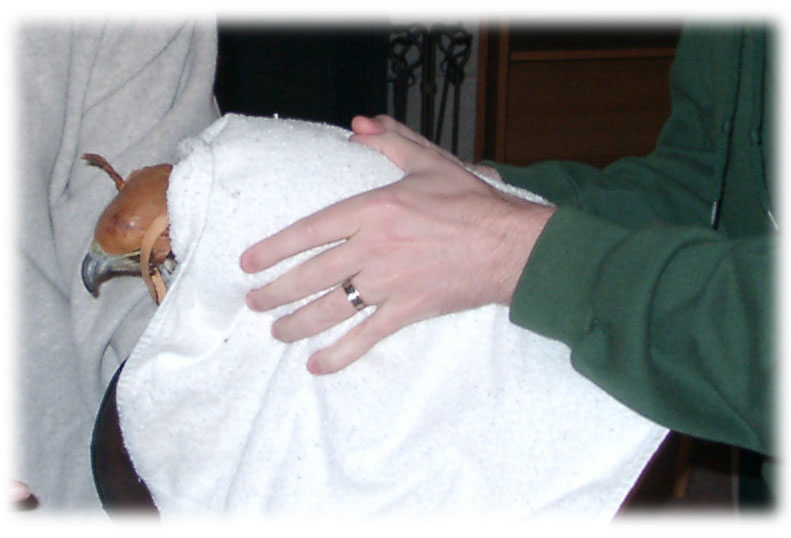 |
With one falconer holding the bird on the fist, the assistant falconer will hold the bird with the towel. |
A smaller bird can be held in an ice cream cold hold, similar to holding a bouquet of flowers. If you need to cast a small bird and are uncertain on the handling and positions, practice on a frozen quail or starling, or defrost the quail and practice on that.
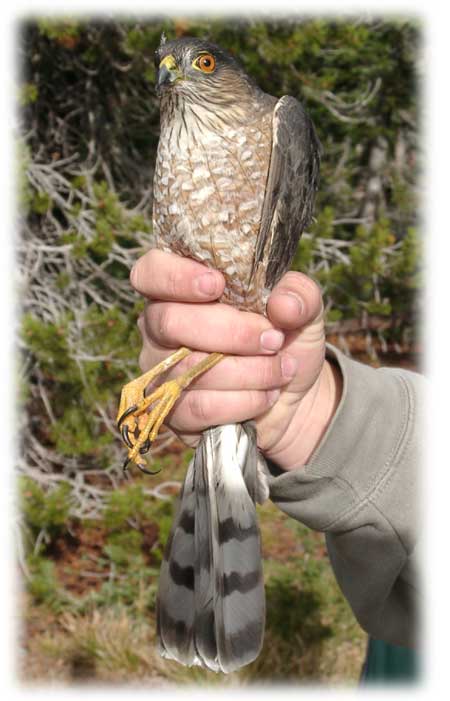 |
With one falconer holding a small bird. |
The bird will instinctively grasp hard at the glove or anything else she can reach. The assistant should have a solid hold of the bird with his hands making a sort of cage around her, not crushing or constricting her, but just restraining her. For a large bird, the assistant falconer's thumbs should meet across the bird's back, the index and second fingers should reach around the wings holding them to her sides. The pinkie and ring fingers should hold the thighs back so she cannot reach her feet too far in front of her.
When the bird is under control, the falconer can swing his gloved hand back towards the bird's tail. This will essentially straighten out the bird's body. The bird can now be laid chest down across a pillow.
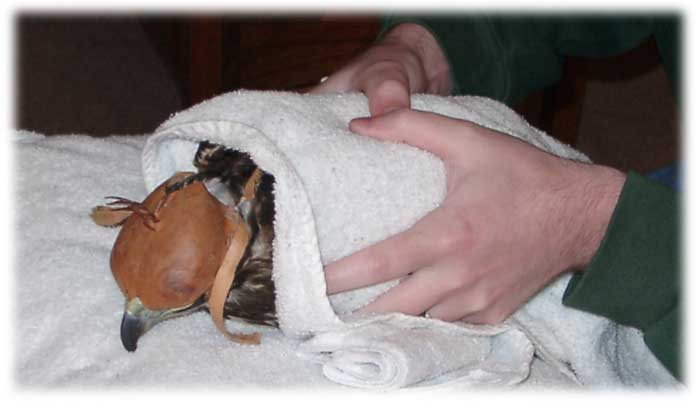 |
The bird can now be laid on a pillow, again be careful not to put pressure on her chest or abdomen else she may suffocate. |
With the bird under control, you can now cope, imp, or assess a bird's condition. If you have one thing to do while your bird is cast, you might as well do several things, such as cope, imp, and inspect her feet. Just be sure not to have her constrained for too long as she becomes more likely to overheat. An aba restraint is also a wonderful tool for casting.
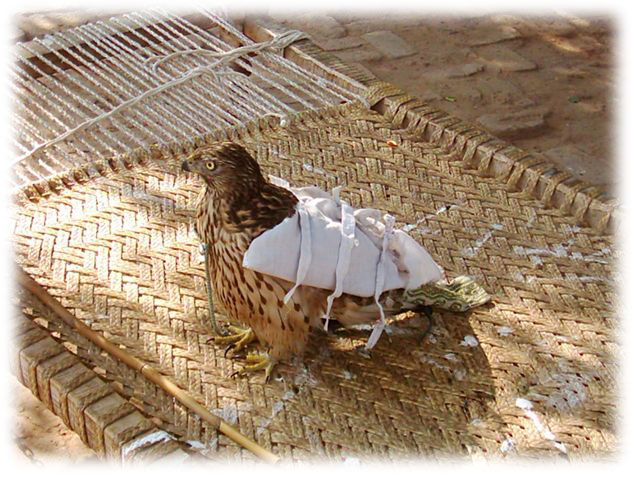 |
A bird in an Aba restraint.
Photo courtesy of Salman Ali. |
When done, the falconer should put the glove back on. The assistant will lift the bird up; her feet will be dangling slightly. The falconer should try to work the glove into the bird's grasp being careful not to get anything but the glove near her. Once the bird has a good grip on the glove, the assistant can release her and remove the towel. Alternatively, if the assistant cannot lift the bird, he can just let go and remove the towel. The bird will eventually stand up and can me navigated onto the glove.
When you finish, it's a good idea to end on a positive note. The falconer should place a large hunk of meat into his glove. When the hood is removed, the bird is immediately rewarded for the whole experience with a large piece of meat.
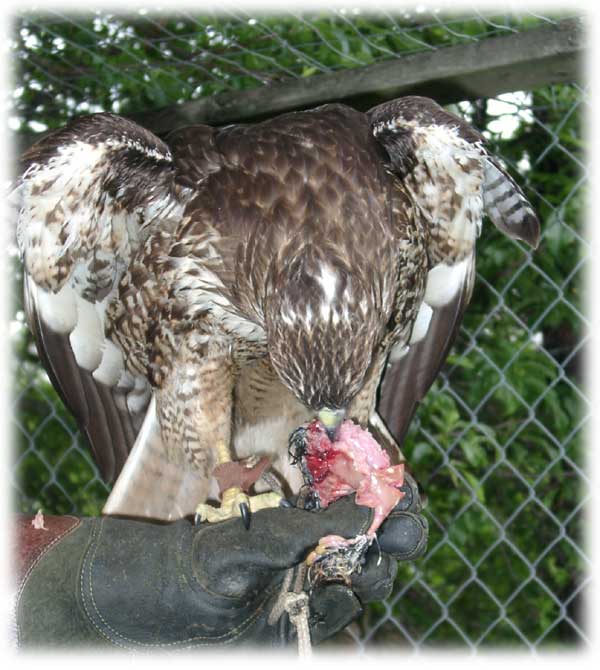 |
If there is not a second handler available, a bird can still be cast. If hooding is not possible consider a darkened room or a dark room with a strobe light flashing slowly. Small birds, like a Cooper's Hawk or Merlin, can be grasped easily with you right hand wile the hawk is standing on your gloved left hand. Another method is to have the bird standing hooded and to grab her from behind. This can be difficult as she can easily get a foot up and grab the handler. Once in hand, a bird can be slipped into a cardboard tube. A Pringles can with the metal edge cut off and holes poked in the opposite end is a common tool used by bird banders and rehabilitators. Coffee cans are also frequently used for larger birds like a Snowy Owl. Others use 18" lengths of stovepipe or PVC pipe as they can get these in a variety of diameters. They are closed at one end with a flat cap and some holes poked in it. Some will even very lightly spray a tiny amount of silicone spray to better allow a bird to slide in and out without ruffling her feathers. This silicone treatment lasts for a very long time and doesn't need to be refreshed for many uses. A general guideline is to use a 6" tube for a Goshawk sized bird, a 5" tube for a Cooper's Hawk sized bird, and a 3" sized tube for a Sharp-Shin sized bird. The disadvantage of tubes is that they can be wiggled out of and so a hawk will need to be observed carefully to ensure she is not about to get free. A tube can have two holes at the open end with a leather strap across to help ensure a bird cannot back her way out. Another option for restraint is an Aba, or similar wrapper. These are just a triangle of cloth that will wrap around the entire bird, with several velcro straps that will prevent her from moving her wings. A bird held in an ice cream cone hold can have a simple wrap put around her and the velcro secured and will be quite comfortable for examination or procedures. The head is exposed for coping or examination or gavage, if necessary, and the feet are exposed if they need to be examined or worked on, while the rest of the body is contained. If needed, a tennis ball or wad of cloth can be placed in a bird's foot then the foot can be taped around it so that it grips the wadding. This prevents the bird from grabbing any handler and keeps her from puncturing herself. Vet wrap, painter's tape, or masking tape are all sufficient for wrapping the foot around an appropriately sized material. A women's nylon stocking also makes an excellent restraint as a bird can be slipped into the stocking and the stocking will constrict the bird enough to prevent much movement, but not enough to impair her breathing. However, a bird can fight against the nylon material and pull it down over her entangling herself or freeing herself. A piece of masking tape can be wrapped around the bird's "equator" to reinforce the nylon and secure her from struggling. Ace bandages have been used, but they are so strong and able to be stretched that they are more likely to be over-constrictive to the bird.